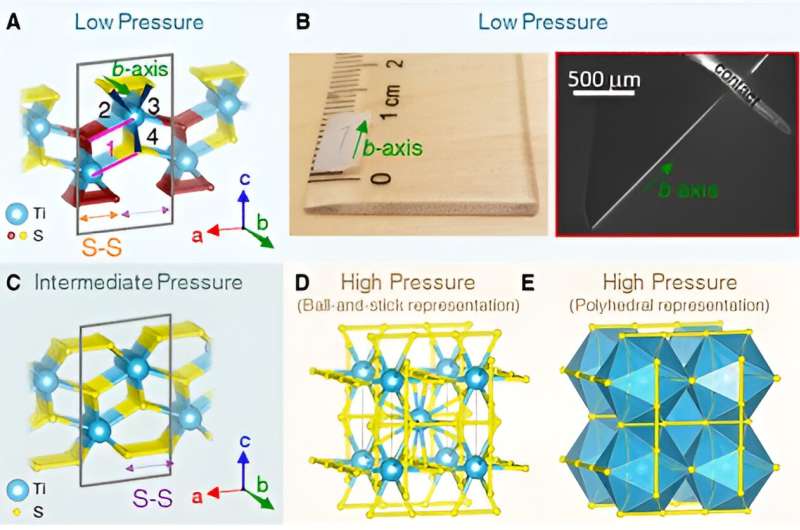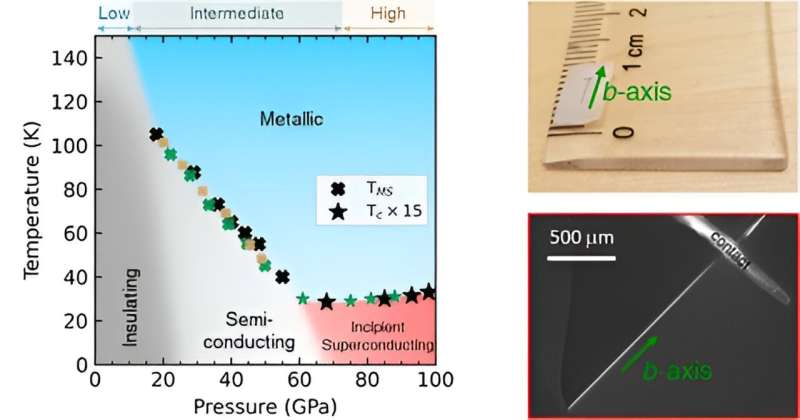This article has been reviewed according to Science X's editorial process and policies. Editors have highlighted the following attributes while ensuring the content's credibility:
fact-checked
peer-reviewed publication
trusted source
proofread
Compressed titanium and sulfur nanoribbons can transmit electricity without energy loss, scientists find

When compressed, nanoribbons of titanium and sulfur can change properties dramatically, turning into materials with the ability to conduct electricity without losing energy, according to a study published in the journal Nano Letters.
The authors have made the discovery during their painstaking search for new materials that can transmit electricity without loss of energy, a hot topic that has for long haunted the scientific community.
"Our research focuses on one such promising material: TiS3 nanoribbons, which are tiny, ribbon-like structures made of titanium and sulfur. In their natural state, TiS3 nanoribbons act as insulators, meaning they do not conduct electricity well," says Mahmoud Rabie Abdel-Hafez, an associate professor at University of Sharjah's Department of Applied Physics and Astronomy.
"However, we discovered that by applying pressure to these nanoribbons, we could change their electrical properties dramatically," adds Abdel-Hafez, who is the study's main author.
The scientists exposed TiS3 to gradual pressure. As they increased the pressure, they found that the TiS3 system underwent a series of transitions, from being insulators to becoming metals and superconductors, for the first time.
TiS3 materials are known to work as good insulators, but it is the first time scientists have discovered that under pressure they can function as superconductors, paving the way for the development of superconducting materials.
"Superconductors are special because they can conduct electricity with zero energy loss, which is incredibly valuable for technological applications," says Abdel-Hafez. "[But] imagine a world where electrical power could be transmitted without any energy being wasted as heat. This would revolutionize how we use and distribute electricity, making everything from power grids to electronic devices far more efficient."
It is exactly this potential which the authors tout as a breakthrough: the potential of TiS3 to turn into materials causing no waste when transmitting electricity. By carefully controlling the pressure applied to these materials, the authors identified the exact points where they changed from one state to another.
"This is significant because understanding these transitions helps us learn how to manipulate other materials in similar ways, bringing us closer to discovering or designing new superconductors that can operate at higher temperatures and more practical conditions," notes Abdel-Hafez .
The study shows that TiS3 has the potential to become such a material when subjected to the right conditions. By gradually increasing the pressure on the investigated materials, the authors observed that they transitioned from being insulators (poor conductors) to metals (good conductors) and finally to superconductors (perfect conductors with no energy loss).

Discovering that TiS3 materials can become superconductors under pressure is certain to help scientists understand more about the conditions required for superconductivity. This knowledge is crucial for developing new materials that might be superconductors at higher, more practical temperatures, the authors maintain.
"This research not only enhances our understanding of superconductivity but also demonstrates the power of international collaboration in achieving groundbreaking scientific results," affirms Sweden's Uppsala University Professor of Physics and Astronomy, a co-author.
The project is part of University of Sharjah's research quest to develop materials that can transmit electricity without energy loss, offering new insights into how pressure can transform the electrical properties of TiS3 nanoribbons.
The study is a joint endeavor in which scientists from Sweden, China and Russia took part. "This advancement not only pushes the boundaries of material science but also holds the promise of groundbreaking applications in various fields, including energy transmission and electronic devices," says Abdel-Hafez.
On the method adopted to conduct the study, the authors write that they pursued "experimental and theoretical approaches to comprehensively explore the high-pressure behavior of the electronic properties of TiS3, a quasi-one-dimensional (Q1D) semiconductor, across various temperature ranges.
"Through high-pressure electrical resistance and magnetic measurements at elevated pressures, we uncover a distinctive sequence of phase transitions within TiS3, encompassing a transformation from an insulating state at ambient pressure to the emergence of an incipient superconducting state above 70 GPa."
According to Abdel-Hafez, the study paves the way for finding new superconductors, a hunt which he likened to "the search for the holy grail in materials science because these materials can conduct electricity without any energy loss. This is crucial as it could lead to incredibly efficient power transmission and numerous technological advancements."
However, the authors note more research is needed to understand how these superconductors work and the theories behind them, topics which are still hotly debated in the literature. "In our research paper on TiS3 materials, we found that we could change their electrical properties dramatically.
"These materials have the potential to revolutionize power transmission by enabling electricity to be conducted without any energy loss. Additionally, they could advance technologies in medical imaging, electronic devices, and transportation systems such as maglev trains," says Abdel-Hafez.
The authors are upbeat about the implications of their findings. They note, "Our findings provide compelling evidence that superconductivity at low temperatures of ∼2.9 K is a fundamental characteristic of TiS3, shedding new light on the intriguing high-pressure electronic properties of TiS3."
More information: Mahmoud Abdel-Hafiez et al, From Insulator to Superconductor: A Series of Pressure-Driven Transitions in Quasi-One-Dimensional TiS3 Nanoribbons, Nano Letters (2024). DOI: 10.1021/acs.nanolett.4c00824
Journal information: Nano Letters
Provided by University of Sharjah





















